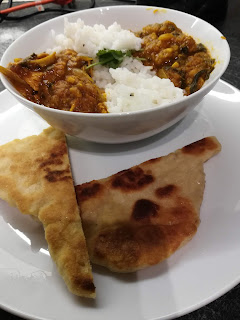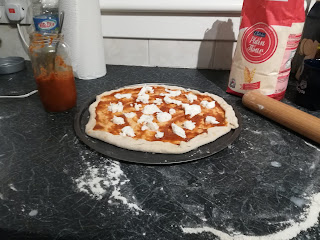Today's tip is a great way to save yourself time and money when cooking during the week. We're talking about batch cooking.
What is Batch Cooking?
Batch cooking is where you create a base (with meat or vegetables) which you can use to make several different meals. The purpose of this is to get the main part of cooking over and done with so that you can cook your meals in around half the time during the week. The base can be frozen.
How is it done?
So to do batch cooking, you're going to need some base ingredients (onions, garlic, stock) and some form of meat. Today, I'm going to talk through batch cooking with mince and a few different meals that you can make with a simple base (However, this list is just some suggestions. You can turn your base in to whatever you want!)
Batch Cooking Mince
You'll need some onions, garlic and mince. Chop and fry the onions and garlic and add in the mince. Season and cook until the meat is browned. Pour in some beef stock and simmer for 10 mins. This creates your base.
Bolognaise
Add your meat base to a pan. Add pasatta, oregano, basil. Simmer until your pasta is cooked and then serve.
Burritos
Add your meat base to a pan. Add cumin, chili and paprika. Simmer until your rice is cooked. Add to tortilla wraps with the rice.
Mince & Tatties
Add your meat base to a pan. Add in some frozen peas, Worcestershire sauce and a bay leaf. Simmer for 10 mins. Serve with potatoes.
This is just one example of how you can batch cook your food. It's important that you buy as big a pack of mince as you can as the base can be frozen for later use. This will save you more time and money!
You don't always need to use meat in the base sauce. Fried onions and garlic cooked with pasatta makes a great base for any sauce and will still save you a lot of time.
OneHungryStudent | Cheap, Student Eats
My name is Ruaridh and I'm a Third Year Marketing and French student at Strathclyde University. While at uni, I've discovered a few secrets that have helped me to lower my living costs and I've found some great recipes along the way as well. I'll be sharing these tips, as well as some of my favourite recipes, on this blog as well as on social media.
Tuesday, October 16, 2018
Saturday, October 13, 2018
Saturday Night Takeaway - Madras Curry
This weekend's takeaway of choice is the classic curry. This is a great dish to be able to make as it is so versatile. You can put pretty much whatever meat or vegetables you have in to this curry recipe and it will taste delicious! (My favourite that I've tried so far is using a cod fillet.)
I know that some of these spices aren't things you usually have in the cupboard (ie Garam Masala) but they are easy to find and are a great investment with how cheap these meals are. My main advice would be to check in world food sections of supermarkets to get the best price on these spices.
1 x Onion (Sliced)
2 x Garlic Cloves
400g x Chopped Tomatoes
450ml x Vegetable/Chicken Stock
2 tsp x Garam Masala
2 tsp x Curry Powder
1 tsp x Cumin
1 tsp x Turmeric
1 tsp x Salt
Chilli Powder (to taste)
1 Handful x Coriander
Some Frozen Spinach (Optional)
Either
1 Mug x Lentils (Cooked)
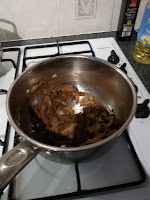 OR 1 x Chicken Breast (Cooked)
OR 1 x Chicken Breast (Cooked)
1. Fry the onions in a little oil in a saucepan. Once they have softened, add the garlic, salt and spices. Add a little water so that you create a kind of paste. Cook this for a few minutes.
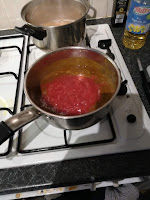
2. Add the stock and the chopped tomatoes to the base and bring to a simmer.
3. Add the meat/vegetables of your choice and simmer for 10-15 mins.
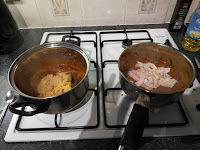
4. Stir in the coriander and cook for another 5 mins.
5. Serve with your choice of side dish (Rice or naan bread)
Naan bread recipe I used
The lentil curry comes in at £1.50 and the chicken curry at £2.30. Each of these will easily feed 2 people. That's a great saving of £6 on the takeaway (Not including the delivery fee) so why not treat yourself to a few Cobra beers as well.
I know that some of these spices aren't things you usually have in the cupboard (ie Garam Masala) but they are easy to find and are a great investment with how cheap these meals are. My main advice would be to check in world food sections of supermarkets to get the best price on these spices.
 My Magic Madras
My Magic Madras
1 x Onion (Sliced)
2 x Garlic Cloves
400g x Chopped Tomatoes
450ml x Vegetable/Chicken Stock
2 tsp x Garam Masala
2 tsp x Curry Powder
1 tsp x Cumin
1 tsp x Turmeric
1 tsp x Salt
Chilli Powder (to taste)
1 Handful x Coriander
Some Frozen Spinach (Optional)
Either
1 Mug x Lentils (Cooked)
 OR 1 x Chicken Breast (Cooked)
OR 1 x Chicken Breast (Cooked)Method
1. Fry the onions in a little oil in a saucepan. Once they have softened, add the garlic, salt and spices. Add a little water so that you create a kind of paste. Cook this for a few minutes.

2. Add the stock and the chopped tomatoes to the base and bring to a simmer.
3. Add the meat/vegetables of your choice and simmer for 10-15 mins.

4. Stir in the coriander and cook for another 5 mins.
5. Serve with your choice of side dish (Rice or naan bread)
Naan bread recipe I used
The lentil curry comes in at £1.50 and the chicken curry at £2.30. Each of these will easily feed 2 people. That's a great saving of £6 on the takeaway (Not including the delivery fee) so why not treat yourself to a few Cobra beers as well.
Labels:
budget,
budgeting,
Curry,
Food,
meal,
money-saving,
saver,
saving,
student,
Takeaway,
Vegan,
Vegetarian
Tuesday, October 9, 2018
Tuesday Tips & Tricks - Meal Planning
Follow my blog with Bloglovin
One of the biggest mistakes that students make when it comes to food (and uni work) is that they don’t plan. This can take a massive drain on your finances and your time if you’re shopping from meal to meal rather than buying a week’s worth of shopping. Today, I’m going to be talking you through how to effectively plan a week’s worth of meals so that you only need to go to the shops once a week, thus saving you both time and money.
One of the biggest mistakes that students make when it comes to food (and uni work) is that they don’t plan. This can take a massive drain on your finances and your time if you’re shopping from meal to meal rather than buying a week’s worth of shopping. Today, I’m going to be talking you through how to effectively plan a week’s worth of meals so that you only need to go to the shops once a week, thus saving you both time and money.
 |
| An example of a 2-week meal plan. |
Using a template such as the one above, you can easily plan out each week’s meals (either electronically or on a printout). That way you can buy exactly what you need at the start of the week and you can be more focused in the shop.
What you need to do to save money
- If you actually want to save money then you need to be quite strict when you go to the shop. That means making a list of everything that you need for that week’s meals. This will stop you prospectively buying stuff that you won’t use and would end up throwing in the bin.
- Checking your freezer for anything that you’ve bought reduced in previous weeks will help you save money. You should buy reduced food at the supermarket and use it in the following week's plan to save even more money!
- Make sure that you can re-use some items. If you’re buying food that comes in larger packages (ie; mushrooms, carrots etc) make sure that you can use them in 2/3 meals that week. This will stop you from wasting food that’s going out of date. You can see from my example how this works.
- Don't be afraid to stray away from your meal plan if other things get in the way (eg, if a friend asks you out for dinner). Just don't make a habit out of it if you want to save money.
Saturday, October 6, 2018
Saturday Night Takeaway - Pizza
Pizza Sauce
1 x Onion (Diced)
2 x Garlic Cloves (Diced)
1 x Handful of Basil (Chopped)
1 x tsp Oregano
250g x Passata
Salt, Pepper and Sugar (To Season)
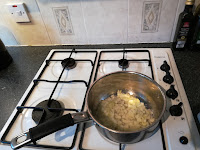 Method
Method
1. In a saucepan, fry the onions in a little oil. Add some salt and pepper. After 5 minutes add the garlic and then fry for a further 5 minutes.

2. Add the passata to the pan with a sprinkle of sugar (or a tsp of honey)
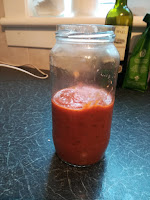 3. Add the herbs to the mixture then bring to a light simmer for 5 minutes. Taste and adjust the seasoning based on your preferences.
3. Add the herbs to the mixture then bring to a light simmer for 5 minutes. Taste and adjust the seasoning based on your preferences.
4. Blitz in a blender if you have one (although this is not essential.) Store in the fridge for later.
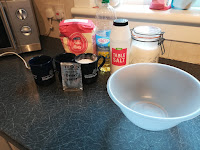
Pizza Dough
1½ x Mugs of Plain Flour
½ x Mug of Warm (Not Boiling) Water
1 x Sachet fast-action Yeast
1 x tbsp Oil
1 x Pinch Salt and Sugar
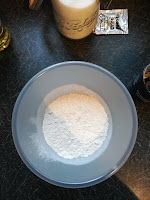
Method
1. Put the flour, yeast, salt and sugar in a large mixing bowl.
2. Add the oil and water. Stir until the mixture comes together.
3. Sprinkle flour on to a clean work-surface. Move the dough on to the surface and begin to knead. Add more flour if the dough is too sticky. Knead for between 10-15 minutes.

4. Leave in a clean bowl for around 1 hour. The dough will rise during this time. Hit the dough so that the air is taken out then leave for another 30 minutes.
5. Roll out the dough onto a baking sheet. Add the sauce and whatever toppings you like.
This recipe makes one 12 inch pizza. If you want to make more pizzas, just multiply the ingredients.
Making a margherita pizza with this recipe costs £1.49 (and this goes down the more pizzas you make). That's £5 less than the best deal at Dominos. Or 2 extra vodka cokes on your Saturday night out.
1 x Onion (Diced)
2 x Garlic Cloves (Diced)
1 x Handful of Basil (Chopped)
1 x tsp Oregano
250g x Passata
Salt, Pepper and Sugar (To Season)
 Method
Method1. In a saucepan, fry the onions in a little oil. Add some salt and pepper. After 5 minutes add the garlic and then fry for a further 5 minutes.

2. Add the passata to the pan with a sprinkle of sugar (or a tsp of honey)
 3. Add the herbs to the mixture then bring to a light simmer for 5 minutes. Taste and adjust the seasoning based on your preferences.
3. Add the herbs to the mixture then bring to a light simmer for 5 minutes. Taste and adjust the seasoning based on your preferences.4. Blitz in a blender if you have one (although this is not essential.) Store in the fridge for later.

Pizza Dough
1½ x Mugs of Plain Flour
½ x Mug of Warm (Not Boiling) Water
1 x Sachet fast-action Yeast
1 x tbsp Oil
1 x Pinch Salt and Sugar

Method
1. Put the flour, yeast, salt and sugar in a large mixing bowl.
2. Add the oil and water. Stir until the mixture comes together.
3. Sprinkle flour on to a clean work-surface. Move the dough on to the surface and begin to knead. Add more flour if the dough is too sticky. Knead for between 10-15 minutes.
I KNEAD PIZZA RN

4. Leave in a clean bowl for around 1 hour. The dough will rise during this time. Hit the dough so that the air is taken out then leave for another 30 minutes.
5. Roll out the dough onto a baking sheet. Add the sauce and whatever toppings you like.
This recipe makes one 12 inch pizza. If you want to make more pizzas, just multiply the ingredients.
Making a margherita pizza with this recipe costs £1.49 (and this goes down the more pizzas you make). That's £5 less than the best deal at Dominos. Or 2 extra vodka cokes on your Saturday night out.
Tuesday, October 2, 2018
Tuesday Tips and Tricks - Reduced Food
Welcome to the first Tuesday Tips & Tricks on this blog. A segment looking at things we can do to save money on our weekly shops. This week I’m going to talk about a relatively well-known tip but I’m going to explain how to really make the most of the savings.
You may be wondering: How do I get the most out of reduced food from the supermarkets? And to answer that I’ve put together a handy checklist that you can use while you’re out and about at the shops.
- 1. Is it freezer-ready?
- This is one of the most important things to think about when buying reduced food. Most of the time, you’re not going to be eating the stuff that you’re buying that day, so you need to make sure that you can keep it fresh until you actually want to use it.
- 2. Have I already got this in my freezer?
- This is something that I forget about at least once a month. You don’t want to be buying too much of the same thing if you’re not going to eat it.
- 3. Will I actually cook this?
- This links back to point 2. Don’t buy food just because it’s cheap. If you can’t think of a use for it, don’t put it in your basket.
- 4. Is it a good deal?
- Not everything that has been branded yellow is a good deal. Sometimes the savings are so small that it isn’t worthwhile, especially on name-brand items. For example, a block of cathedral city cheddar may be reduced by 50p, but the own brand cheese is £1 cheaper. Always check other products first.
- 5. Is it the right time?
- Try to find out what time your local supermarket starts to reduce its products. That way you’ll be able to get the best choice of the deals, so you can save the most money.
Subscribe to:
Posts (Atom)
